Wintering Wildlife – 3 Ways North Carolina Species Brave the Cold Season
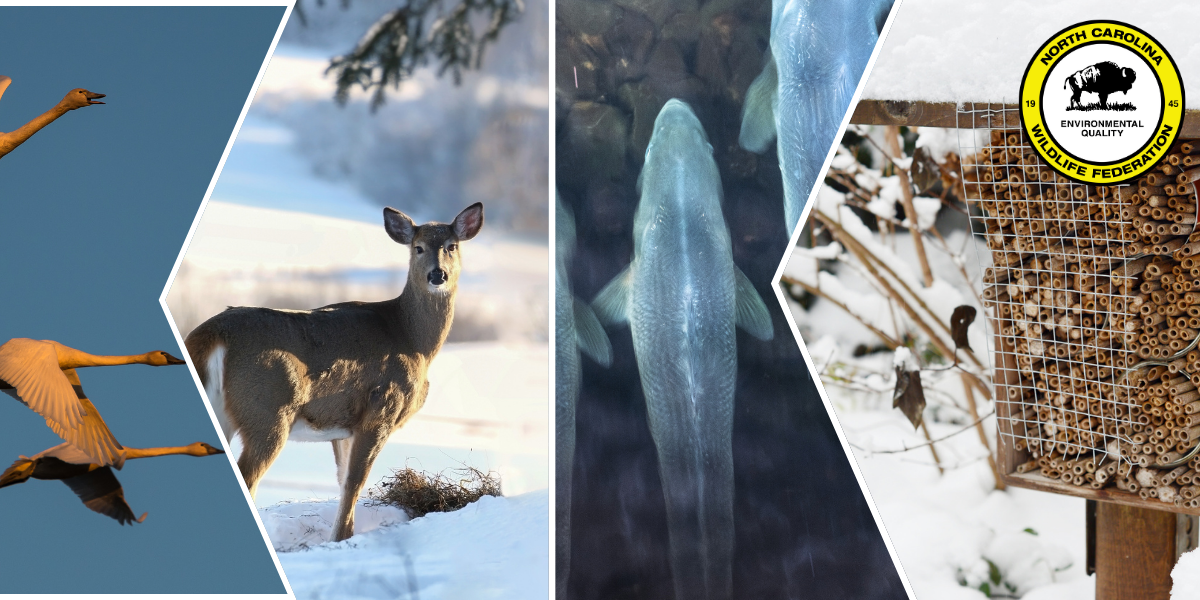
What do you know about wintering wildlife?
In December, the coldest months of the year are upon us.
In the winter, you’re probably sitting in a temperature-controlled building, or wearing warm clothing to insulate yourself against the cold outside. Over centuries, we humans have developed innovative technologies and tactics to keep ourselves both cool in the heat of summer and warm in the cold of winter. But we are not the only species to adapt in such a way to the elements!
While squirrels do not have a heating unit in their treetop dreys, snakes don’t have toboggans, and Canada geese don’t have snow shoes – all of these species have ways of adapting to the cold winter season.
Let’s take a deep dive into the wintering habits of some North Carolina wildlife species!
Wintering Wildlife: Insulation, Hibernation, and Migration
There are three general ways of coping with cold weather: bundle up with supplementary warming layers, travel somewhere where it’s not so cold, or huddle in a warm little nook and bear through it until the spring warmth rolls around.
Wildlife – and humans – utilize all of these techniques, and in the world of wildlife, these are called insulation, hibernation, and migration.
Wintering Wildlife: Insulation
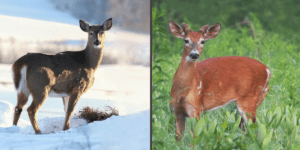
Whitetailed deer winter coat and summer coat
Insulation refers to a layer of material that reduces heat transference, essentially keeping heat in and cold out. While we utilize fiberglass insulation in our homes, synthetic insulation in our blankets and jackets, and double-walled insulation in coolers and thermoses… wintering wildlife insulates in more natural ways, namely through the addition of extra fat and fur.
As an example, white-tailed deer spend much of their time in the fall months browsing for food. While this serves to give them energy during the fall mating season, it also builds up their fat reserves for winter, when food is more scarce on the landscape. These fat reserves both provide for their nutritional needs and pack on an extra layer of warmth.
Additionally, deer shed their coats twice a year – once for the summer and once for the winter. When the hot months of summer pass, the deer begin shedding their thin reddish-brown layer of summer fur to be replaced by a thick brownish-gray coat that is up to six times deeper and thicker than their summer coat! Under a coat of protective guard hairs, every hair in their winter coat is hollow and holds an insulating layer of air to retain body heat.
Many other mammals rely on these methods of insulation, and even some birds add an extra layer of fat for winter, as well!
However, just because a species may add a layer of winter insulation doesn’t mean that it won’t utilize other forms of overwintering habits. In fact, some species put on an extra layer of fat specifically to utilize while they are inactive during their period of hibernation.
Wintering Wildlife: Hibernation
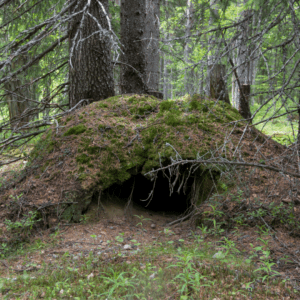
Example of large hibernaculum
Hibernation refers to a prolonged state of low activity and metabolic depression that occurs in some wintering wildlife species during the cold months of the year. During these periods, warm-blooded animals (mammals) undergo a decrease in body temperatures, resulting in a lethargic state to conserve energy for warmth. Similarly, brumation is a state of low activity and metabolic depression in cold-blooded animals (reptiles and amphibians).
Hibernation is often confused with torpor, with the difference being that hibernation is a prolonged and seasonal state of inactivity with few interruptions. Torpor is a temporary state of low body temperature and low activity, usually lasting no longer than a few hours or days. Therefore, hibernation may be thought of as an extreme and prolonged period of torpor.
During these periods of hibernation and brumation, wildlife seek out locations referred to as hibernaculums – safe and concealed places of refuge to wait out the winter in peace. Depending on the wildlife species, these hibernaculums look very different, though they share the characteristics of being out of the open, and relatively enclosed for the retenance of body heat.
As large mammals, black bears seek out larger hibernaculums such as rock crevices, hollow tree trunks, cavities under roots, or other natural or artificial confined areas. In colder climates, black bears have been known to hibernate for up to seven months, though the hibernation
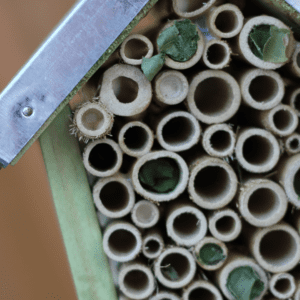
“Bee hotels” provide native pollinators with hibernaculums in the absence of natural hibernating locations
period is much shorter in warmer climates, such as North Carolina. On the warmer North Carolina coast, black bears may not hibernate at all, and will remain active in their natural range.
Species like snakes, turtles, and amphibians enter brumation by escaping into the ground, beneath the frost layer. Some species of turtles rear their young before winter, but the hatched young will brumate underground and wait until spring to emerge for the first time.
Even some insects go through a phase of hibernation called diapause, where their growth and development are paused until the warmer months of spring roll around. During diapause, social insects such as honeybees will huddle together for warmth within their hive.
Solitary insect species – such as leafcutter bees, praying mantises, mud daubers, and carpenter bees – do not have the warmth and the luxury of a colony to keep them warm, and thus seek out confined spaces for solitary diapause. These places include burrows just under the surface of the soil, hollow plant stems, and layers of leaf matter.
Landowners are encouraged to “leave the leaves” and refrain from mulching or cutting their lawn during these critical periods of insect and pollinator hibernation. Forcing insects and other wildlife species out of their shelter during times of hibernation, brumation, or diapause can result in their injury or death.
Wintering Wildlife: Migration
For some wintering wildlife species, the solution to braving the winter months is simply to migrate to warmer winter climates. However, migration meets other needs in addition to providing warmer temperatures.
Migration refers to the movement of animals from one place to another in search of better temperature conditions, more plentiful food sources, or mating opportunities. Often, their priorities lie in the latter two motivations – which come as a result of warmer winter climates.
Though some groups of mammals migrate from one climate to another in the western United States, many of the migratory species in North Carolina are either birds or coastal fish species.
Birds
There are many migratory bird species that visit North Carolina for a time before migrating back to another climate with the change of the seasons.
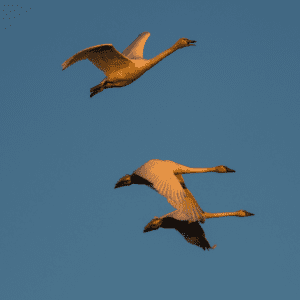
Tundra swans migrating south for winter
Ruby throated hummingbirds – and several other hummingbird species – migrate to North Carolina from mid-March to early April, once the temperatures start heating up and plentiful nectar sources are in full bloom. As temperatures drop toward the end of fall and the floral sources become more scarce, most hummingbirds will migrate back to their wintering range in Mexico and Central America.
Some other migratory birds that make warm weather migrations in North Carolina are purple martins, American goldfinches, swallows, warblers, Indigo buntings, tanagers, ospreys, and even some robins.
Conversely, some species of migratory birds spend some or all of the winter season in North Carolina. Tundra swans spend most of their time in the Arctic and Alaska before migrating to warmer climates in mid-September, including some of North Carolina’s coastal regions – particularly the Pungo Unit on the Pocosin Lakes National Wildlife Refuge.
Other migratory birds that winter in North Carolina include snow geese, Red-winged blackbirds, Black-eyed juncos, Yellow-bellied sapsuckers, and some sparrows.
Fish
Many fish species migrate not to escape winter conditions but for reproductive purposes. However, their reproductive cycle and schedule
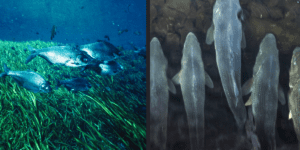
Gizzard shad (left) and striped bass (right) migrate from the coast into inland streams to spawn
largely depend on water temperatures, which vary by location. Water temperature and other environmental factors influence the viability and survival of fish eggs and larvae, so spawning fish have to seek out the perfect conditions for their young.
Some fish species, such as sturgeon, alewife, blueback herring, striped bass, and American shad are anadromous, meaning they spend most of their time in saltwater but migrate to freshwater to spawn. American eels are the only catadromous fish species in North Carolina, meaning they spend most of their time in freshwater, but migrate to saltwater to spawn.
Since herring require 58 to 61-degree water temperatures to spawn, freshwater ponds and slow-moving streams are often just the right conditions at the turn of the season.
Striped bass venture inland as well, and North Carolina’s Roanoke River is one of the most popular striped bass spawning locations. The bass venture from the Atlantic Ocean and the Albemarle Sound inland up to 130 miles up the Roanoke River and spawn once the water has reached 62 degrees.
Since many species rely on inland waterways and coastal estuaries for spawning and rearing of young, they are heavily impacted by the harmful practice of bottom trawling for shrimp.
Bottom trawling targets these estuaries, which serve as nursery areas for young fish. These captured fish – or “bycatch” – are killed and discarded back into the water, decimating the coastal ecosystem.
In response, NCWF has developed Save Our Sounds, a program to educate others on the perils of commercial bottom trawling and stand for the protection of our North Carolina sounds and estuaries – and the wildlife within them.
Written by:

– Bates Whitaker, NCWF Communications & Marketing Manager

